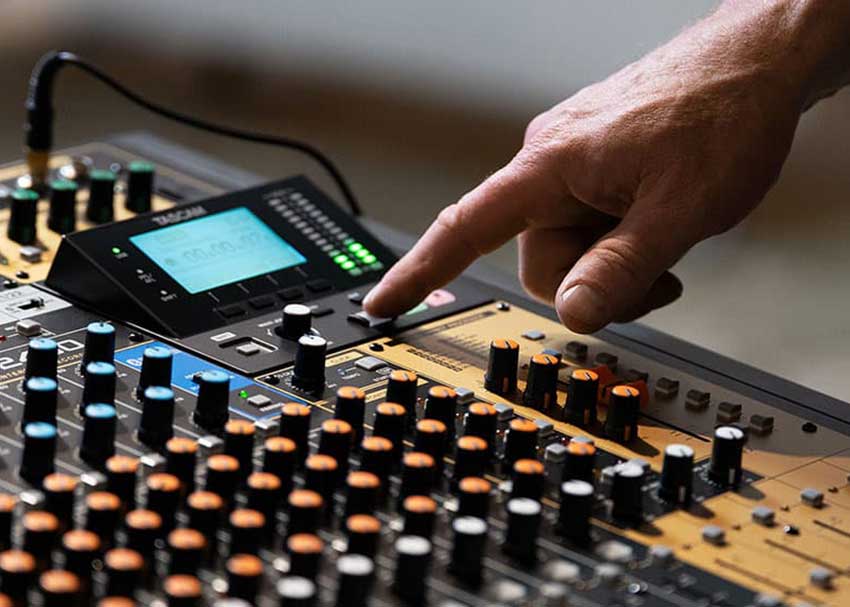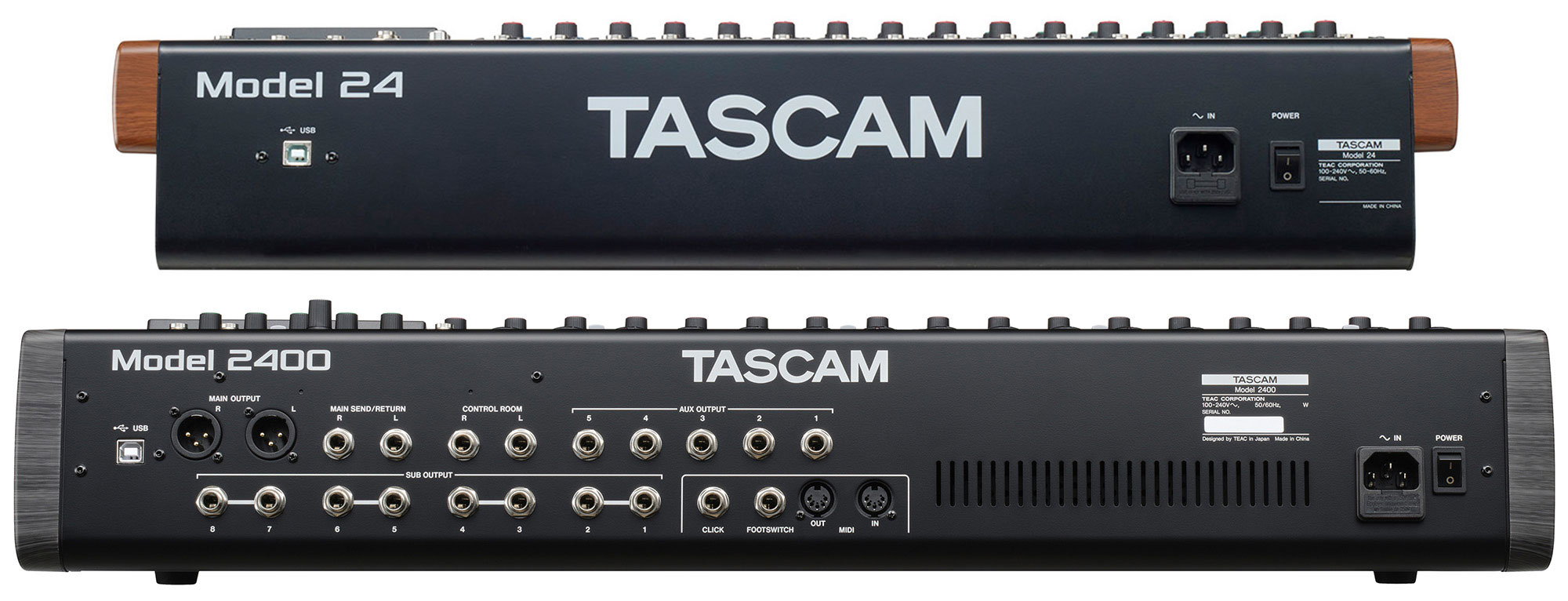Since its 2018 release, TASCAM’s Model 24 mixer/interface/recorder has proved to be an easy-to-use and pro-sounding solution for multitrack recording. Now, the venerable recording gear maker has followed up their hit with the TASCAM Model 2400. Though it looks similar at first glance to the predecessor, the TASCAM Model 2400 is a beast under the hood, with a slew of new features that make it the flagship of the “Model” series — and worth its considerably higher price point. In this blog post, we’ll take a closer look at the TASCAM Model 24 vs. Model 2400 and compare their features.
What’s New and Different in the Model 2400?
Starting at the top of the mixer and moving down, here are features unique to the Model 2400 compared to the Model 24:
– Phantom Power on banks of 4 channels: Instead of the Model 24’s single, global Phantom +48V button that turns phantom power on/off for every input at once, the Model 2400 has individual phantom on/off switches for each bank of 4 inputs. So if you need phantom for some of your condenser mics or DI boxes, you can turn it on for just those channels — without worries about accidentally sending phantom power to a delicate ribbon mic. This feature makes the Model 2400 more well-suited for the studio than its predecessor.
– Upgraded Ultra-HDDA preamps: The Model 2400 upgrades its 16 preamps to TASCAM’s Ultra-HDDA (High Definition Discrete Architecture) mic preamps with EIN (Equivalent Input Noise) of -128 dB. (You’ll also find these preamps on TASCAM’s Model 16 and Model 12, but not on the original Model 24.)
– XLR-1/4″ combi jacks on first 20 inputs: Combination (aka combi or combo) jacks can accommodate both an XLR or an 1/4″ input. These aren’t necessarily an upgrade, but they do look cooler than having an XLR jack next to a 1/4″ jack like on the Model 24 — and who knows, they may even eliminate a moment of confusion about where your signal is coming from.
– Stereo channel 21/22 now has 1/4″ TRS inputs on the Model 2400, vs. RCA and 1/8″ input jacks on the Model 24. (Both 24 and 2400 have a Bluetooth receiver on this channel.)
– Insert jacks on the first 12 channels (vs. only the first two channels on the Model 24): These standard TRS jacks let you connect external effects processors using TRS insert cables (tip send, ring return, sleeve ground).
– Switchable REC-OUT (POST-EQ) on the first 20 input channels: Set a channel to POST-EQ to record its signal with the EQ applied — or keep it switched out to record raw audio. This is useful if you need to dial in EQ for a live performance, but want to capture the full-range raw signal, whatever’s coming into the input jack, to SD card or to your computer over USB.
– Bypass switches for comp/EQ on the first 20 input channels: Hit this button to bypass a channel’s one-knob compressor and EQ and hear what your processing hath wrought.
– 5 auxes vs. 3 auxes: The Model 2400 has 5 aux sends (1 selectable pre/post fader) instead of 3 aux sends, now with 1/4″ TRS outputs on the back of the mixer, rather than on the top panel as on the Model 24.
– 4 stereo subgroups: Where the Model 24 had just a single subgroup (assigned via the Main and Sub buttons for each channel fader), the Model 2400 boasts four — with buttons labeled Main, 1-2, 3-4, 5-6, and 7-8 on each channel fader. Each of those 4 stereo subgroups has its own group fader on the right side of the console, and each of those 4 faders feeds a pair of SUB OUTPUT 1/4″ TRS jacks on the back, and can also be assigned to the main mix. Great for mixing live, subgroups can come in handy anytime you want to control multiple channels — like all your drum mics, or all your backing vocal mics — with a single fader.
– Talkback mic jack: Model 2400 adds a dedicated XLR mic input labeled Talkback, assignable to Aux 1-4 or the Main bus. (You no longer have to eat a channel to plug in a talkback mic.)
– Room for more headphones: Two 1/4″ TRS headphone output jacks on the Model 2400, as opposed to the Model 24’s one.
– Master Bus Processor section: New to the Model 2400, this section lets you apply a digital stereo compressor (with 5 physical knobs) and a 4-band digital Master EQ (controlled via the screen menu) to your Main Mix. Hit the MASTER BUS IN switch to send your Main Mix through this processor. This Master Bus Processor replaces the 7-band analog graphic EQ found on the front panel of the Model 24.
– Way more outs on the back: Note only are the 4 subgroup outs and 5 aux sends on the back, the XLR Main Outs and 1/4″ TRS “Control Room” outs have now moved to the back panel of the Model 2400, as opposed to the top panel on the Model 24. You’ll also find a pair of 1/4″ TRS Main L/R Send/Return insert jacks on the back panel.
– MIDI I/O: Want to plug a MIDI keyboard into your mixer and send it to your DAW over USB? The Model 2400 can do that. Want to generate MIDI Timecode (MTC) and send MIDI Clock/SPP (Song Position Pointers) when playing back or recording on the SD Card? Model 2400 can do that, too.
– DAW transport control: If you’re plugging into a computer via USB, you can use the Model 2400’s DAW Control Mode to let its Stop, Play/Pause, and Record buttons control your DAW transport and go to markers in your DAW projects, using Mackie Control and HUI protocol emulation supported by major DAWs. Plus, the Record Arm buttons on each of the Model 2400’s channel faders control that feature on DAW tracks, and the multi-jog wheel on the Model 2400 allows for scrubbing in your DAW of choice. Here’s to less mousing on a screen and more flying through your sessions!
– Built-in metronome: The Model 2400 has a metronome with tap tempo with a footswitch jack, and the metronome click has its own dedicated 1/4″ output jack on the back.
– Upgraded display: The Model 2400’s screen is a bit larger and sharper compared to the Model 24.
TASCAM Model 24 vs. Model 2400: What’s the Same?
Both the Model 24 and Model 2400 say “mixer/interface/recorder” right on the front panel, which describes their capabilities in a nutshell. And these two products still have a lot in common:
Mixer: Both the Model 24 and Model 2400 are analog mixers at their hearts — each with 22 inputs, including 16 mic preamps, and 100mm faders. The first 12 channels offer one-knob compressors and sweepable mids on the 3-band EQs. The only not-analog part of the mixer’s signal path is the digital effects processor, with 16 on-board effects (reverb, delay, chorus, flanger).
Interface: Both Model 24 and Model 2400 boast a 24-in/22-out USB interface for sending multitrack audio to a DAW (and back out from your DAW, so you can monitor through your mixer and even use it for analog summing.) This robust USB I/O qualifies both these boards as hybrid mixers.
Recorder: Both the 24 and 2400 have an onboard Portastudio-style multitrack recorder: they let you capture 24 channels (that’s all 22 input channels, plus a stereo mix) directly to an SD/SDHC/SDXC card at up to 24-bit/48 kHz resolution, with the ability to punch in/out on up to 8 tracks independently. So whether you want to record with a computer or without, the Model 24 and Model 2400 can meet your needs.
TASCAM Model 24 vs. Model 2400: Is the 2400 Worth the Extra Cost?
Compared to the Model 24, the Model 2400 offers vastly upgraded and expanded I/O, including Ultra-HDDA preamps, inserts on the first 12 channels, 5 aux sends, 4 stereo subgroups, master bus insert jacks, MIDI, and more! It’s fully equipped to be the heart and brain of your studio or live setup.
So if you’re buying a mixer for the cool brown wood side panels alone, then you’ll have to stick with the old favorite Model 24. But for just about every studio and live situation, TASCAM’s Model 2400 will give you a great deal more flexibility. In conclusion, it’s clear that the Model 2400 offers just about everything the Model 24 does, and a great deal more.




